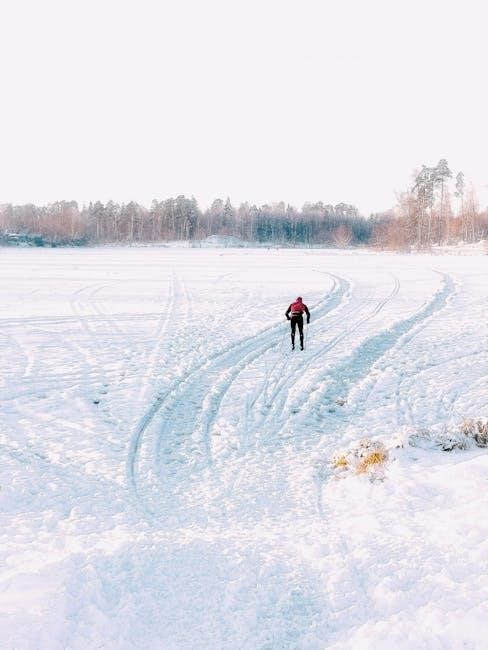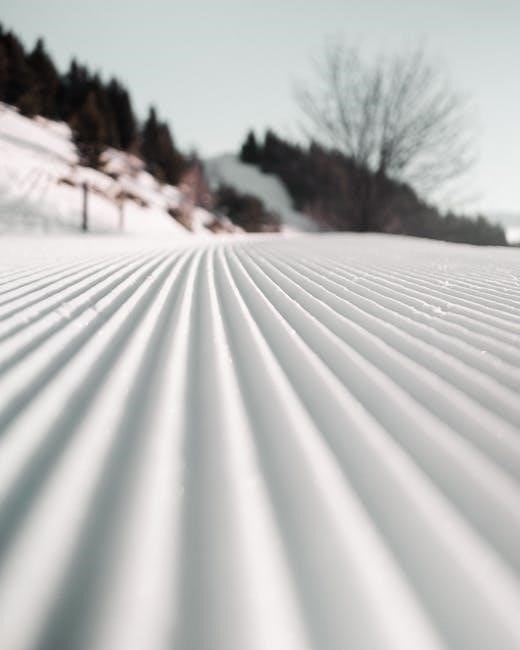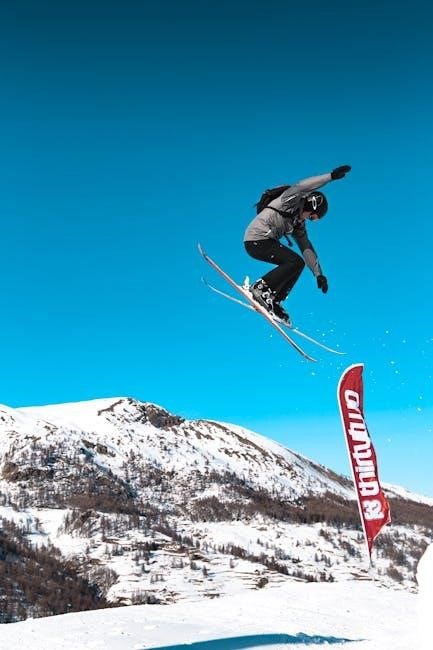Choosing the right ski size is crucial for optimal performance and enjoyment on the slopes. This guide helps determine the perfect fit based on height‚ weight‚ ability‚ and style‚ ensuring a better skiing experience.

Why Ski Sizing is Important
Proper ski size is essential for ensuring optimal performance and safety on the slopes. A ski that is too long can be difficult to control‚ while one that is too short may lack stability at higher speeds. The right ski length enhances maneuverability‚ allowing for quicker turns and better balance. It also impacts the ski’s ability to float in powder or carve through groomed trails. Incorrect sizing can lead to fatigue‚ as skiers may struggle to manage their equipment. Additionally‚ proper sizing ensures the ski’s flex and responsiveness match the skier’s weight and ability‚ providing a more enjoyable and effective skiing experience. By selecting the correct size‚ skiers can maximize control‚ confidence‚ and overall performance across various terrain and conditions.

Determining Your Ski Size
Determining the right ski size involves considering factors like height‚ weight‚ and skiing style. Using a ski size chart or calculator helps find the perfect fit for optimal performance.
Standard Ski Length Calculation
The standard method for calculating ski length considers a skier’s height‚ weight‚ and ability level. Generally‚ ski length ranges from just above the chin to the top of the head. For beginners‚ shorter skis (around eyebrow level) are easier to handle‚ while advanced skiers may prefer longer skis for stability at higher speeds. Weight also plays a role‚ with heavier skiers often needing longer skis for better floatation. Using a ski size chart or calculator can provide a tailored recommendation‚ ensuring the perfect balance between maneuverability and performance. These tools typically factor in height‚ weight‚ and skiing style to determine the ideal length. Adjustments may be made based on personal preference or specific skiing conditions‚ such as powder or carving. Proper ski length enhances control‚ stability‚ and overall skiing enjoyment.
Height-Based Ski Sizing
Height is a primary factor in determining ski length‚ with most skis falling between the skier’s chin and the top of their head. For adults‚ this typically ranges from 160cm to 190cm. Beginners often prefer shorter skis‚ around eyebrow level‚ for easier maneuverability‚ while advanced skiers may opt for longer skis‚ closer to the top of the head‚ for stability at higher speeds. Junior skis are sized based on the child’s height‚ with a general range of 70cm to 150cm. Weight and ability level can influence adjustments‚ but height remains the foundational measurement. Properly sized skis ensure better control‚ balance‚ and performance‚ making the skiing experience more enjoyable. Always consult a ski size chart or calculator for precise recommendations tailored to individual needs.
Weight and Body Measurements
Weight and body measurements play a significant role in determining the ideal ski size. A skier’s weight influences the pressure applied to the skis‚ affecting their performance and stability. Generally‚ lighter skiers may prefer shorter skis for easier control‚ while heavier skiers might benefit from longer skis to maintain stability at higher speeds. Body measurements‚ such as foot size for boot compatibility‚ also contribute to overall fit and comfort. Ski length recommendations often consider weight alongside height and ability level to ensure optimal balance and maneuverability. Advanced skiers may prefer stiffer skis to handle their weight and skiing style effectively. Consulting a ski size chart or calculator can provide personalized recommendations‚ blending weight‚ height‚ and other factors for the perfect fit. Properly sized skis enhance control‚ stability‚ and overall skiing performance.

Skiing Style and Ability Level
Skiing style and ability level significantly impact ski size selection. Lighter skiers or those prioritizing control may prefer shorter skis‚ while heavier or advanced skiers often opt for longer skis to enhance stability and performance.
How Skiing Style Impacts Size
Your skiing style plays a crucial role in determining the ideal ski size. Aggressive skiers who prioritize speed and stability often prefer longer skis‚ which provide better control at higher speeds. Conversely‚ those who focus on agility and quick turns in tighter spaces may opt for shorter skis. Skiing techniques‚ such as carving or all-mountain exploration‚ also influence size choices. For example‚ all-mountain skis are typically longer for stability in varied terrain‚ while freestyle skis are shorter for easier maneuverability in parks. Additionally‚ skiers who enjoy powder or backcountry skiing often choose longer skis for better floatation in deep snow. Personal preference‚ such as whether you value playfulness or precision‚ further tailors the size selection to match your on-snow behavior and goals.
Beginner vs. Advanced Skiers
Beginner skiers typically benefit from shorter skis‚ as they are easier to control and maneuver‚ making it simpler to learn basic turns and balance. Shorter skis also allow for quicker edge-to-edge transitions‚ which are essential for building confidence on the slopes. Advanced skiers‚ however‚ often prefer longer skis‚ as they provide greater stability at higher speeds and better performance in challenging terrain. Longer skis also allow for more precise control and smoother turns‚ which are critical for advanced techniques like carving or navigating steep slopes. The flex of the ski and its overall design also vary between these groups‚ with advanced skis often featuring stiffer constructions for power and responsiveness. Ultimately‚ the skill level significantly influences the optimal ski size‚ ensuring the best possible performance and enjoyment for each skier.

Using Ski Size Charts and Calculators
Ski size charts and calculators help determine the ideal ski length by considering height‚ weight‚ and skiing style‚ ensuring optimal performance and comfort for all skiers‚ from beginners to experts.
Understanding Ski Size Charts
Ski size charts are tools designed to help skiers find the ideal ski length based on their height‚ weight‚ and ability level. These charts typically provide a range of recommended lengths‚ allowing for personal preference adjustments. By aligning your height and weight with the chart‚ you can determine a baseline length‚ which can then be refined based on skiing style and terrain preferences. For example‚ shorter skis are better for maneuverability‚ while longer skis offer stability at higher speeds. Ski size charts often include tables or graphs that organize data clearly‚ making it easier to identify the appropriate size. While they serve as a reliable starting point‚ factors like skiing ability and personal comfort may require deviations from the chart’s recommendations. This ensures the best fit for an enjoyable and effective skiing experience.
Using a Ski Size Calculator
A ski size calculator is a valuable tool that helps determine the ideal ski length by considering multiple factors‚ such as height‚ weight‚ ability level‚ and skiing style. By inputting your details‚ the calculator provides a personalized recommendation‚ ensuring a precise fit tailored to your needs. This method is more accurate than standard charts because it accounts for individual preferences and skiing goals. For example‚ aggressive skiers may prefer longer skis for stability‚ while those prioritizing maneuverability might opt for shorter lengths. The calculator also simplifies the process for beginners‚ offering clear guidance without overwhelming them with technical details. Ultimately‚ it serves as a reliable starting point‚ allowing you to refine your choice based on personal comfort and skiing conditions. This approach ensures a more enjoyable and efficient experience on the slopes.
Additional Considerations
Additional factors like children’s sizing‚ personal preference‚ and skiing conditions can influence your ski size choice; Adjustments may be needed for optimal comfort and performance.
Children’s Ski Sizing
Children’s ski sizing is tailored to their height and weight‚ ensuring proper control and maneuverability. Junior skis are generally shorter‚ with lengths ranging from 30% to 60% of the child’s height. Factors like age‚ ability‚ and weight influence the ideal size. For younger kids‚ shorter skis (around chin height) are recommended for ease of handling‚ while taller or more advanced children may opt for slightly longer skis. Adjustments can be made based on the child’s skill level and growth rate. Using a youth-specific ski size chart or calculator is essential to find the perfect fit‚ ensuring the skis are neither too cumbersome nor too short. Proper sizing enhances learning‚ confidence‚ and overall enjoyment on the slopes.
Adjusting for Personal Preference
While ski size charts provide a solid starting point‚ personal preference plays a significant role in fine-tuning your ski length. Some skiers prefer shorter skis for easier maneuverability and quicker turns‚ ideal for slower speeds or tight spaces. Others opt for longer skis to enhance stability at higher speeds or in challenging terrain. Skiing style also influences this choice; aggressive carvers or racers might favor longer skis for better edge hold and control‚ while freestyle enthusiasts often prefer shorter skis for increased agility. Comfort and confidence are paramount‚ so it’s essential to consider how the ski feels during use. Adjustments may vary based on individual skiing habits‚ terrain preferences‚ and even the frequency of use. Ultimately‚ personal preference ensures the skis align with your unique skiing experience and goals.



